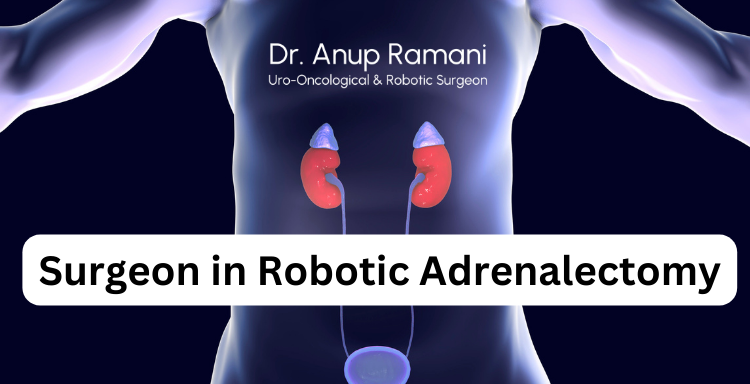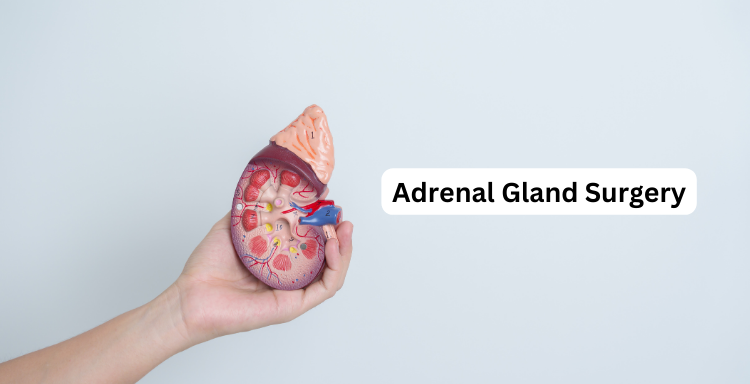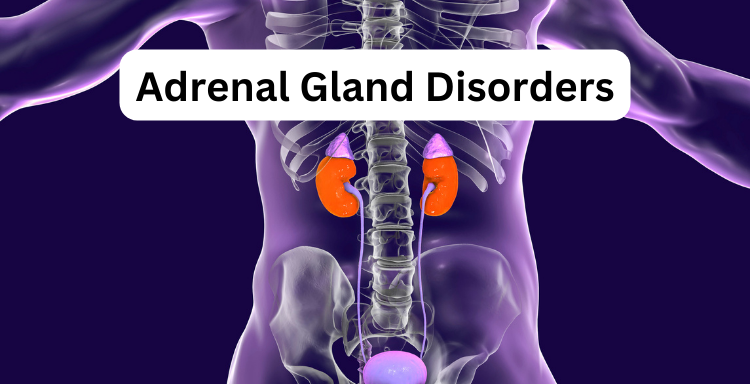Dr Anup Ramani @ Copyright 2024
By Dr. Anup Ramani
Understanding Adrenal Gland Disorders and Treatment Options
Adrenal gland disorders can significantly impact a person’s health, given the crucial role the adrenal glands play in hormone production. These small glands, located atop the kidneys, produce hormones that regulate metabolism, blood pressure, and stress responses. When adrenal tumors or other abnormalities arise, surgery is often necessary. Traditionally, open surgery or laparoscopic techniques were used to remove affected glands. However, advances in Minimal invasive methods, particularly robotic adrenalectomy, have revolutionized the way adrenal gland surgeries are performed.
What is Robotic Adrenalectomy?
Defining Robotic Adrenalectomy
Robotic adrenalectomy is a Minimal invasive surgical procedure used to remove one or both adrenal glands using advanced robotic technology. Unlike traditional open or laparoscopic adrenalectomy, robotic surgery employs small incisions, robotic arms, and a high-definition camera to offer the surgeon enhanced precision and control during the procedure. This allows for more accurate tumor removal while sparing surrounding tissues and vital structures.
When is Robotic Adrenalectomy Recommended?
Robotic adrenalectomy is most commonly recommended for conditions such as adrenal tumors, pheochromocytomas, adenomas, and hyperplasia. Patients with these conditions benefit from this approach due to its Minimal invasive nature, which reduces the risk of complications and shortens recovery time. Additionally, it’s an excellent option for patients with larger tumors or those located in difficult-to-access areas, where precision is key.
Benefits of Robotic Adrenalectomy
Advantages Over Traditional Surgery
One of the primary benefits of robotic adrenalectomy is that it requires much smaller incisions than traditional open surgery, leading to significantly less pain and scarring. The precision offered by robotic technology also reduces the risk of bleeding and infection. Moreover, patients who undergo robotic adrenalectomy often experience faster recovery times, allowing them to return to their normal activities sooner than those who undergo traditional surgery.
Enhanced Precision and Control
The robotic system used in adrenalectomy procedures provides surgeons with an unparalleled level of control. The system translates the surgeon’s hand movements into finer, more precise actions inside the body. This level of precision is particularly beneficial when operating in the narrow, delicate spaces around the adrenal glands, ensuring that the removal of tumors or diseased tissue is accurate and safe.
The Robotic Adrenalectomy Procedure
Step-by-Step Overview of the Surgery
The robotic adrenalectomy procedure begins with the patient being placed under general anesthesia. A few small incisions, typically less than a centimeter in size, are made in the abdomen. Through these incisions, robotic instruments and a high-definition camera are inserted. The surgeon, seated at a console, controls the robotic arms, which mimic the surgeon’s hand movements with greater precision. The adrenal gland or tumor is carefully dissected and removed, and the incisions are closed with minimal scarring.
Role of the Surgeon in Robotic Adrenalectomy
Although robotic technology enhances the precision of the surgery, the surgeon remains in full control throughout the procedure. The success of the surgery largely depends on the skill and expertise of the surgeon operating the robotic system. Surgeons who specialize in robotic procedures are trained to use this technology effectively, ensuring the best possible outcomes for their patients.

Robotic Adrenalectomy vs. Traditional Laparoscopic Adrenalectomy
Key Differences Between the Two Techniques
While both robotic and laparoscopic adrenalectomy are Minimal invasive, robotic surgery offers several advantages over the traditional laparoscopic approach. Robotic surgery provides greater dexterity, three-dimensional visualization, and enhanced precision, which are particularly beneficial in complex cases. In contrast, traditional laparoscopic surgery relies solely on two-dimensional imaging and manual manipulation of instruments, which may be less precise in certain situations.
Patient Recovery and Outcomes
Patients who undergo robotic adrenalectomy typically recover faster than those who have traditional laparoscopic or open surgery. Most patients can return to normal activities within a week or two, compared to the longer recovery times associated with more invasive procedures. Additionally, the cosmetic outcomes of robotic surgery are often better, with smaller, less noticeable scars.
Postoperative Recovery and Care
What to Expect After Robotic Adrenalectomy
After robotic adrenalectomy, patients can expect a shorter hospital stay, typically ranging from one to three days. Recovery at home is relatively quick, with most patients able to resume light activities within a week. Full recovery, including the ability to return to strenuous activities, may take a few weeks. Pain is usually mild and can be managed with over-the-counter medications.
Minimizing Post-Surgery Complications
While robotic adrenalectomy is generally safe, patients should follow their surgeon’s postoperative care instructions closely to minimize the risk of complications such as infection or bleeding. Regular follow-up appointments are essential to monitor recovery and ensure the adrenal glands are functioning properly.
Adrenal Gland Surgery in India
Why India is a Leading Destination for Adrenal Gland Surgery
India has become a leading destination for adrenal gland surgery, offering cutting-edge robotic technology and highly experienced surgeons at a fraction of the cost found in Western countries. The availability of advanced healthcare facilities and highly skilled specialists in cities like Mumbai has made India a preferred location for adrenal gland treatments.
Cost-Effectiveness and Accessibility
Patients seeking Adrenal Gland treatment in India or Adrenal Gland Surgery in Mumbai often find that the combination of world-class care and affordability is unmatched. India’s healthcare system is well-equipped to handle complex procedures like robotic adrenalectomy while keeping costs significantly lower than in many other countries.

Choosing the Right Surgeon for Robotic Adrenalectomy
Finding the Best Robotic Adrenalectomy Surgeon
Selecting a qualified surgeon is critical to the success of robotic adrenalectomy. The best adrenal gland surgeons in India often have extensive experience in robotic surgery, and patients should look for surgeons who specialize in adrenal gland disorders and have a track record of successful outcomes.
Importance of Specialized Care
Specialized care is vital for achieving the best possible results in robotic adrenalectomy. Hospitals and surgeons that focus on adrenal gland surgery offer the highest levels of expertise, improving patient outcomes and ensuring safer, more effective treatments.
Challenges and Risks of Robotic Adrenalectomy
Potential Complications and Risks
As with any surgery, robotic adrenalectomy carries some risks, including bleeding, infection, and injury to surrounding organs. However, the risk of complications is generally lower compared to traditional surgery, thanks to the precision of robotic technology. Patients should discuss these risks with their surgeon and ensure they have a clear understanding of the potential outcomes.
Addressing Concerns About Robotic Surgery
Many patients are initially concerned about the use of robotic systems in surgery, fearing a lack of human control. However, it’s important to understand that the surgeon is fully in control of the robotic instruments at all times. The robot simply enhances the surgeon’s capabilities, allowing for more accurate and less invasive procedures.
Conclusion
Robotic adrenalectomy represents a significant advancement in the treatment of adrenal gland disorders, offering patients a Minimal invasive option with enhanced precision and faster recovery times. As robotic technology continues to evolve, it’s likely that more patients will benefit from this innovative approach to adrenal gland surgery. For those seeking adrenal gland surgery, particularly in India, robotic adrenalectomy provides an effective solution with fewer complications and better outcomes.
FAQs - Robotic Adrenalectomy
How long does it take to recover from robotic adrenalectomy?
Most patients can resume light activities within one to two weeks and fully recover within four to six weeks, depending on the complexity of the surgery.
What are the risks of robotic adrenalectomy?
Potential risks include infection, bleeding, and damage to nearby organs, although these are rare due to the precision of robotic technology.
How does robotic adrenalectomy compare to traditional surgery?
Robotic adrenalectomy offers smaller incisions, less pain, and faster recovery times compared to traditional open surgery, with greater precision than laparoscopic surgery.
Is robotic adrenalectomy available in India?
Yes, robotic adrenalectomy is widely available in India, with many top hospitals and surgeons offering this advanced procedure, especially in cities like Mumbai.
Can any surgeon perform robotic adrenalectomy?
Only surgeons with specialized training and experience in robotic surgery are qualified to perform robotic adrenalectomy, ensuring the best outcomes for patients.
About Author

Uro-Oncological & Robotic Surgeon
Dr. Anup Ramani is a robotic uro-oncological surgeon and an internationally recognized expert in robotic surgery for prostate, kidney and urinary bladder cancers. With more than two decades of robotic experience and 2,000+ robotic procedures, he brings unmatched precision and outcomes to complex uro-oncology cases. He is widely published in his field and is known for a personal, transparent approach-often spending over an hour in initial consultations to educate patients on its disease, surgery and recovery. His expertise spans prostate cancer treatment, kidney and bladder cancer surgery, adrenal gland surgery, kidney stone treatment, penile cancer surgery and enlarged prostate management. Dr. Ramani advocates the advantages of robotic surgery-magnified 3D vision, tremor-filtered precision, minimal scarring, lower blood loss and faster recovery-helping patients return to life sooner.
Table of Contents
Recent Blogs
Best Uro-Oncological surgeon
Specialist in India for Robotic Surgery
MCh, DNB, MS, DNB
Dr. Anup Ramani
CONTACT
Uro-Oncologist in India,
Best Robotic Surgeon for Uro Oncology Surgery
1407, One Lodha Place Next to World Towers Senapati Bapat Marg, Worli, Mumbai. 400013.
Dr Anup Ramani @ Copyright 2024 – Website Maintenance, SEO & GEO by Opal Infotech
- Partial penectomy is done in cases where glans and distal penis is involved with carcinoma.
- Partial penectomy is a type of organ-preserving surgery. Preservation of sexual and micturational function depends on the surgical dissection and reconstruction of residual urethra.
- Patients who develop stones in the kidney or ureter, often experience severe pain.
- This condition usually needs a procedure to remove the kidney stones.
- This procedure is called ureteroscopy and is performed very commonly.
- It does not require any cuts and hence it is painless.
- The procedure is performed with an endoscope inserted through the penis under spinal anesthesia.
- The scope is inserted through the penis into the kidney and stones are dissolved with a laser.
- The procedure takes about 40-50 minutes.
- A catheter (urine pipe) is kept after the procedure to drain the bladder. A stent is kept in the kidney at the same time.
- Patient is mobile and walking in the room the same evening.
- Hospital stay is one night and patient is discharged the next day after removal of the catheter.
- Patient has to come back after six weeks to remove the stent in the kidney.
- Patients can resume office a week after surgery and heavy activities like running, weight lifting, a month after the procedure.
- We offer fixed packages for this procedure which can be obtained by calling our helpline +91 9967666060.
- Men with an enlarged prostate, which is a normal ageing changes, often experiencing difficulty passing urine. This condition usually needs a procedure to trim the prostate and relieve the blockage.
- This procedure is called TURP and is performed very commonly.
- It does not require any cuts and hence it is painless.
- The procedure is performed with an endoscope inserted through the penis under spinal anaesthesia.
- The overgrown prostate is dissolved with a laser bloodlessly.
- The procedure takes about 40 minutes.
- A catheter (urine pipe) is kept after the procedure to drain the bladder.
- Patient is mobile and walking in the room the same evening.
- Hospital stay is two nights and patient is discharged with the catheter, which is removed after 4 days.
- Patients can resume office a week after surgery and heavy activities like running, weight lifting, a month after the procedure.
- We offer fixed packages for this procedure which can be obtained by calling our helpline +91 9967666060.
-
Robotic adrenalectomy is a sophisticated, complex surgery and it is very important that an experienced surgeon performs this surgery to avoid major complications.
-
Once the anesthesia is done, and patient positioned, three micro cuts (3mm each) are made in the patient’s abdomen.
-
The arms of the Da Vinci robot are connected to the cuts via ports (tubes).
-
Dr. Ramani then sits in the controlling console to perform the surgery.
-
On an average, a robotic adrenalectomy takes one hour.
-
The surgery is almost completely bloodless and there has never been any need to transfuse blood after surgery.
-
A urine catheter and bag to drain the bladder is inserted during surgery.
-
A tiny drain pipe may be inserted in the surgical side of the abdomen, connected to a bag.
-
Patient is kept nil-by-mouth the day of the surgery, with IV fluids. Sips of water are started the next day and solid food by day three.
-
The drain pipe, if kept, is removed in the room on day 2 after surgery.
-
The catheter is removed on day two after surgery.
-
Total hospital stay for robotic adrenalectomy is 4 nights (including night before surgery).
-
Post discharge, a doctor from the surgical team visits the patient at home/ hotel room once every day.
On the day of discharge, patient is totally self-sufficient. They are able to walk freely without any pain, dress themselves, shower, toilet and they do not need to hire any nurse or help at home. Almost all patients are back to work within 2 weeks of surgery.
Heavy activities like running, weight lifting can be resumed after a month
Follow up after an adrenalectomy is in the form of CT scans, once a year for 5 years.
Local patients usually meet Dr. Ramani after two weeks to discuss report.Outstation patients are counselled on a phone consultation.
- Dr. Ramani is one of the very few surgeons in India who has the expertise to perform a robotic surgery for bladder cancer, which includes removing the urinary bladder and reconstructing a new bladder robotically.
- Robotic radical cystectomy is an extremely sophisticated, complex surgery and it is very important that an experienced surgeon performs this surgery to avoid major complications.
- Once the anaesthesia is done, and patient positioned, six micro cuts (3mm each) are made in the patient’s abdomen.
- The arms of the Da Vinci robot are connected to the cuts via ports (tubes).
- Dr. Ramani then sits in the controlling console to perform the surgery.
- On an average, a robotic radical cystectomy with an ileal conduit takes 3-4 hours.
- The surgery is almost completely bloodless and there has never been any need to transfuse blood after surgery.
- A urine catheter and bag to drain the new bladder is inserted during surgery.
- Two tiny drain pipe in inserted in the surgical side of the abdomen, connected to a bag.
- Patient is kept nil-by-mouth for 4 days after surgery with IV supplementation of patient’s daily requirements of calories, fats, carbohydrates, proteins and electrolytes.
- The drain pipes are removed in the room on day 3-5 after surgery.
- Total hospital stay for radical cystectomy is 8 nights (including night before surgery).
- Post discharge, a doctor from the surgical team visits the patient at home/ hotel room once every day.
- On the day of discharge, patient is totally self-sufficient. They are able to walk freely without any pain, dress themselves, shower, toilet and they do not need to hire any nurse or help at home.
- Almost all patients are back to work within 6 weeks of surgery. Heavy activities like running, weight lifting can be resumed after two months.
Follow up after a radical a cystectomy is in the form of CT scans, once a year for 5 years.
Histopathology report: Local patients usually meet Dr. Ramani after two weeks to discuss report.
Outstation patients are counselled on a phone consult. Depending on the report, patient may or may not need chemotherapy after surgery.
If chemo is needed, patients may choose to get it done with a medical oncologist of their choice or avail the services of one of the four medical oncologists on our team.
- Robotic partial nephrectomy is a sophisticated, complex surgery and it is very important that an experienced surgeon performs this surgery to avoid major complications. Robotic radical (total) nephrectomy is
- relatively easier but still requires significant experience to consistently deliver results.
- Once the anaesthesia is done, and patient positioned, five micro cuts (3mm each) are made in the patient’s abdomen.
- The arms of the Da Vinci robot are connected to the cuts via ports (tubes).
- Dr. Ramani then sits in the controlling console to perform the surgery.
- On an average, a robotic radical nephrectomy takes one hour and a robotic partial nephrectomy takes about an hour and half.
- The surgery is almost completely bloodless and there has never been any need to transfuse blood after surgery.
- A urine catheter and bag to drain the bladder is inserted during surgery.
- A tiny drain pipe in inserted in the surgical side of the abdomen, connected to a bag.
- Patient is kept nil-by-mouth the day of the surgery, with IV fluids. Sips of water are started the next day and solid food by day three.
- The drain pipe is removed in the room on day 3 after surgery. The catheter is removed on day two after surgery.
- Total hospital stay for radical/partial nephrectomy is 4 nights (including night before surgery).
- Post discharge, a doctor from the surgical team visits the patient at home/ hotel room once every day.
- On the day of discharge, patient is totally self- sufficient.
- They are able to walk freely without any pain, dress themselves, shower, toilet and they do not need to hire any nurse or help at home.
- Almost all patients are back to work within 2-3 weeks of surgery.
- Heavy activities like running, weight lifting can be resumed after a month.
- Follow up after a radical/partial Nephrectomy is in the form of CT scans, once a year for 5 years.
- Local patients usually meet Dr. Ramani after two weeks to discuss report.
- Outstation patients are counselled on a phone consultation.






